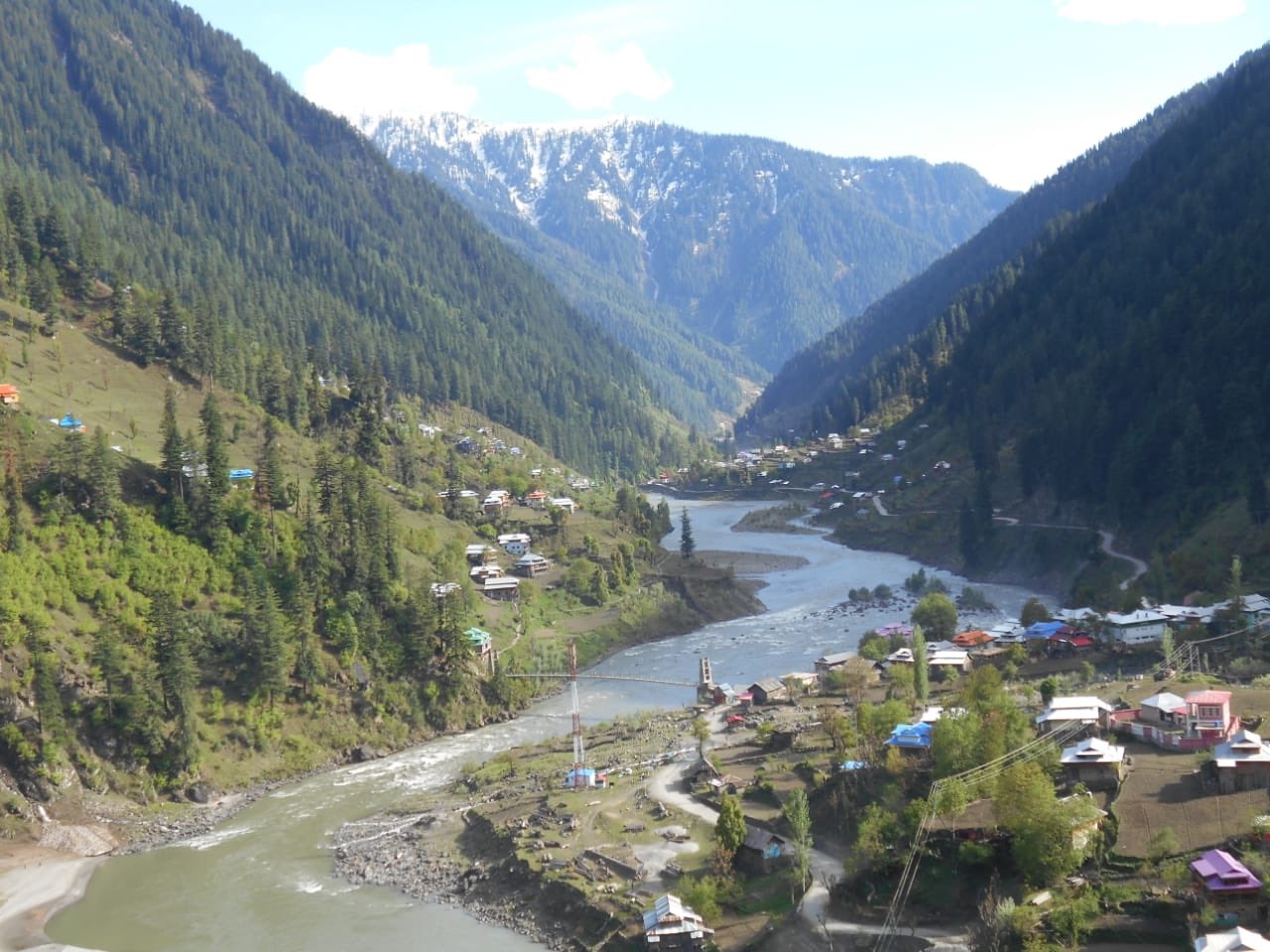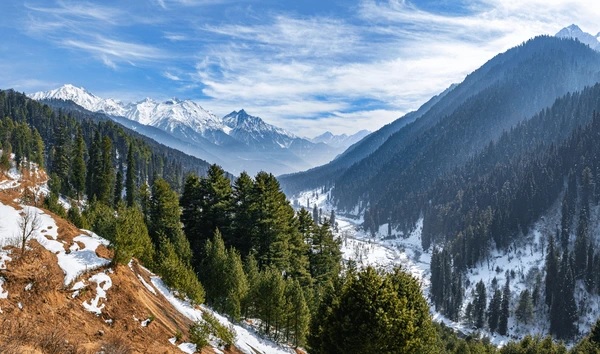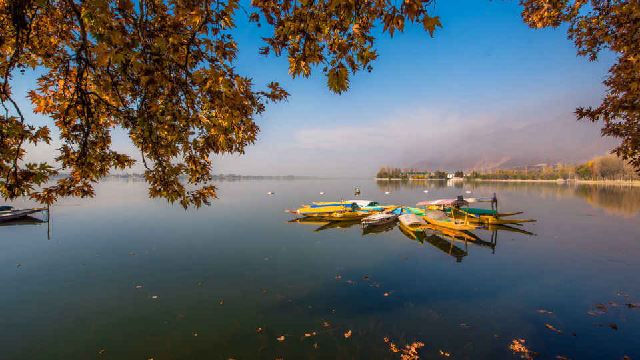By: Tahir Majeed
The 245 kilometres long Kishanganga River originates in the Ganderbal district of Jammu and Kashmir near the Krishansar lake and the popular tourist destination, Sonamarg. The river is a captivating watercourse that flows through various breath-taking valleys of Kashmir. It covers 50 kilometres in the Kashmir valley the remaining 195 kilometres fall in Pakistan occupied Kashmir. From its origin at Sonamarg, the river flows northwards through the Tulail and Gurez Valleys of Kashmir before entering Pakistan Occupied Kashmir. It then continues its course, winding through the Neelum Valley, a lush and picturesque area of Pakistan Occupied Kashmir. At village Tarabal in Baktoor sector of Gurez valley the river makes its first entry into Pakistan Occupied Kashmir at village Taobat of Neelum District. As it enters Pakistan occupied Kashmir, the river is called the Neelum as the name of the river was changed to Neelum in 1956 by Pakistan Government after the partition of India in 1947. Kalhanna in Rajatarangini has mentioned the river as Sindhu. M.A Stein is said to have visited the area and have mentioned its name as valley of Kishen Ganga (Ibid 280). At several places of Kupwara district and Bandipora’s Gurez Valley it forms the line of control at several places like Machil, Keran, Teetwal and Bagtoor. The river finally merges with the Jhelum River near the city of Muzaffarabad, capital of Pakistan Occupied Kashmir.
Tributaries and Valleys: The Kishanganga River is fed by numerous tributaries, including the Raman Sind, the Burzil stream, the Machil and the Kel dara, the Kankatori (or Samgan), and the Jagran River of POK. These tributaries contribute to the unique geography and the lush green valleys that the river flows through.
Also Read | Kashmir as a Honeymoon Destination: Top reasons why to choose?
Religious Significance of the Kishanganga River : The Kishanganga River holds immense religious importance for Hindus, particularly the Krishansar Lake and the Sharada Peeth, an ancient temple and learning centre situated near the river in Neelum valley of POK. These sites were visited by Hindu pilgrims during their annual pilgrimage in ancient period. The Sharada Peeth is revered by the Kashmiri Pandit community and is considered one of the most venerated sites for them. Sharada script, the native script for the Kashmiri language, is named in honor of the main deity of Sharada Peeth. The ancient Sharada Peeth temple, as well as the adjacent ruins of Sharada University are situated in the same Neelam Valley just few miles from Keran . At shardi village where Sharda tample and University is situated the river Kishenganga (Neelum ) joins Madhumati and Sargun streams. Between the 6th and 12th centuries CE, it was among the most prominent temple universities in the Indian subcontinent. Kashmiri Pandit brethren have been demanding opening of the Sharda Peeth corridor for many years now.
Ecological Importance of the River: The Kishanganga River is home to a diverse ecosystem, with various fish species found in abundance in its waters. Some of the most famous fish species found in the river include the Brown trout (Salmo trutta), Rainbow trout (Oncorhynchus mykiss), Snow trout (Schizothorax plagiostomus), Shuddgurn,and Anyour. The river’s proximity to the Line of Control and the uncertainty surrounding the region has resulted in sparse human settlements along its banks, allowing the river’s ecosystem to thrive. As India and Pakistan continue to invest in hydroelectric projects on the Kishanganga River, it is crucial to strike a balance between development and ecological preservation. The river’s rich biodiversity and its religious and historical significance make it an invaluable resource for both countries. It is essential for India and Pakistan to engage in constructive dialogue and cooperation to ensure the sustainable and equitable utilization of the Kishanganga River and its resources for the benefit of their people and the environment.
Also Read | Hidden Delights: Unexplored Vegetarian Cuisines of Jammu and Kashmir await Global Palates
The Indus Waters Treaty and Its Impact on the Kishanganga River: The Indus Waters Treaty, signed between India and Pakistan in 1960, governs the usage and distribution of water from the rivers originating in the Indus River system. According to this treaty, Pakistan has control over the waters of the Indus, Chenab, and Jhelum rivers, while India has control over the Beas, Ravi, and Sutlej rivers. However, the treaty also allows India to use the waters of the western rivers, including the Kishanganga River, for non-consumptive purposes, such as the construction of run-of-the-river hydroelectric projects.
The Kishanganga Hydroelectric Plant: Kishanganga Hydroelectric Plant, a 330 MW project that includes a dam on the Kishanganga River, just meters away from the Line of Control generates 1,713 million units of electricity per year by diverting the waters of the Kishanganga River to an underground power house, which then flows into the Jhelum River. Pakistan raised concerns over this project, claiming that it violates the Indus Waters Treaty by altering the course of the river and depleting the water level downstream. The construction of the 330 MW Kishanganga Hydroelectric Plant commenced after being dormant for many years due to dispute. Later the matter was resolved by the Court of Arbitration of World Bank and on 19 march 2018 Prime Minister Narendra Modi finally inaugurated the project.
The Neelum-Jhelum Hydropower Plant in POK: In response to India’s Kishanganga project, Pakistan has constructed its own hydroelectric project, the 969 MW Neelum-Jhelum Hydropower Plant, on the river. This project has been developed with the help of a Chinese consortium.
Also Read | Best Places for Destination Wedding in Kashmir
Tourist Spots located on the Banks of Kishanganga: I have visited almost all the areas through which the river flows. These include the border areas where this historic river acts as line of control dividing the humans living in Pakistan Occupied Kashmir and in Kashmir valley. These areas were used as an infiltration corridor by the insurgent outfits in past and even now. Thus the Kishanganga river remains under strict observation of the security agencies. People living along LoC and Kishanganga have been victims of the shells and bombs. As on February 25, 2021, India and Pakistan agreed to strictly observe all ceasefire agreements along the LoC and other sectors. With the efforts of Indian Army, the concept of border tourism is a reality now. Lets have a brief introduction of these Kishanganga areas :
Tulail Valley: The Tulail Valley is a captivating region in Indian-administered Kashmir where the Kishanganga River flows through. This valley is characterized by its striking landscape, rich vegetation, and abundant wildlife. It is an area of immense natural beauty, teeming with picturesque vistas and serene spots. Whether you’re looking to unwind in the peaceful surroundings or embark on adventures in the mountains, Tulail Valley offers a perfect escape from the chaos of city life. The simple pleasures of nature and quiet moments of solitude will nourish your soul. The Tulail Valley is sub-valley of Gurez which lies 120 kilometres northeast of Bandipora and 200 kilometres from Srinagar . Tulail Valley lies immediate east of the Gurez Valley.
Gurez Valley: The Kishanganga River originates from the pristine Gurez Valley, nestled amidst the Himalayan peaks. The valley offers breathtaking vistas of lush green meadows, snow-capped mountains, and crystal-clear streams. Visitors can engage in activities like trekking, camping, and trout fishing, or simply soak in the tranquil ambiance of this untouched paradise.
To be continued…..
Also Read| Discovering the Magnificent Lakes of Kashmir: A Must-See on your next Kashmir Trip




